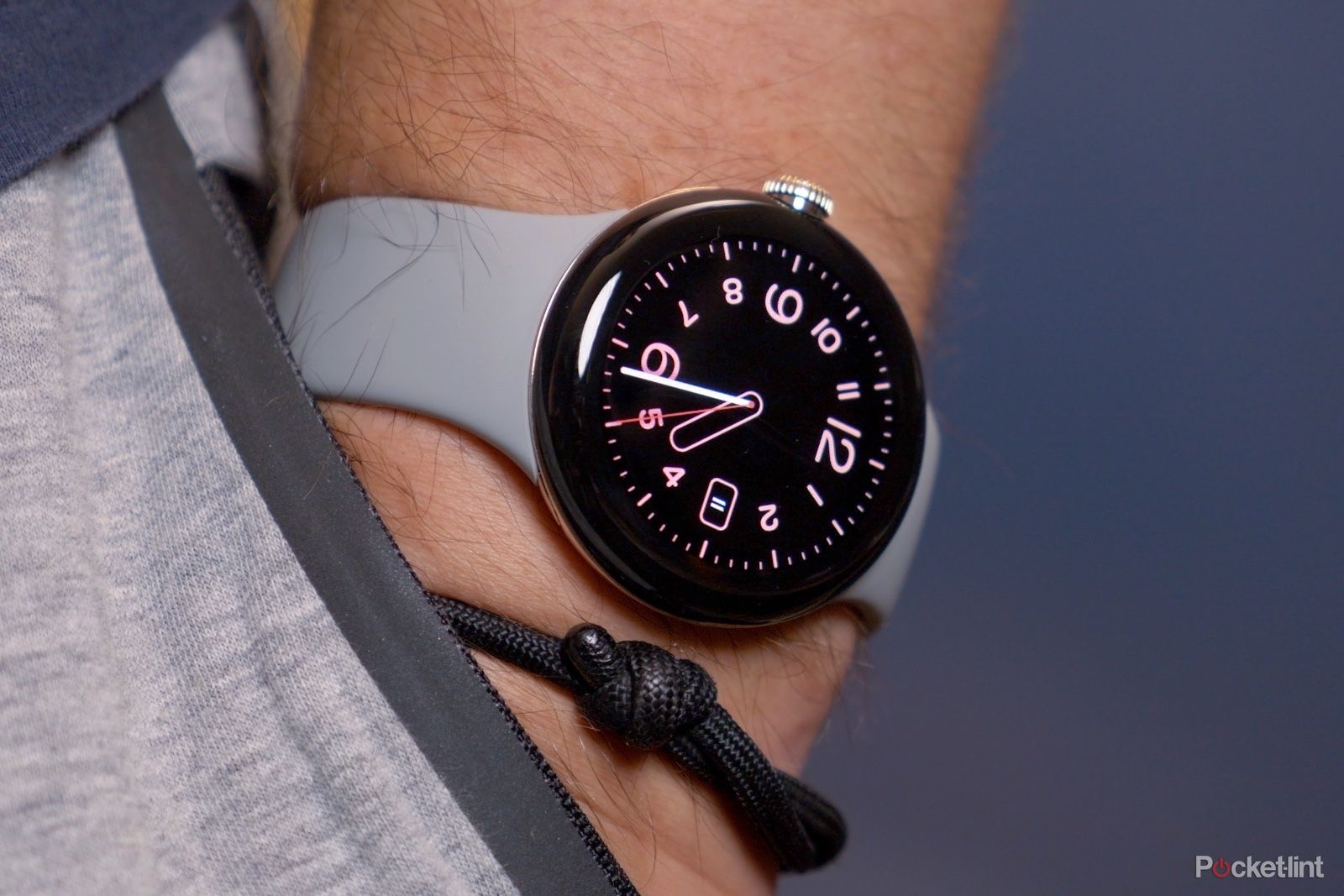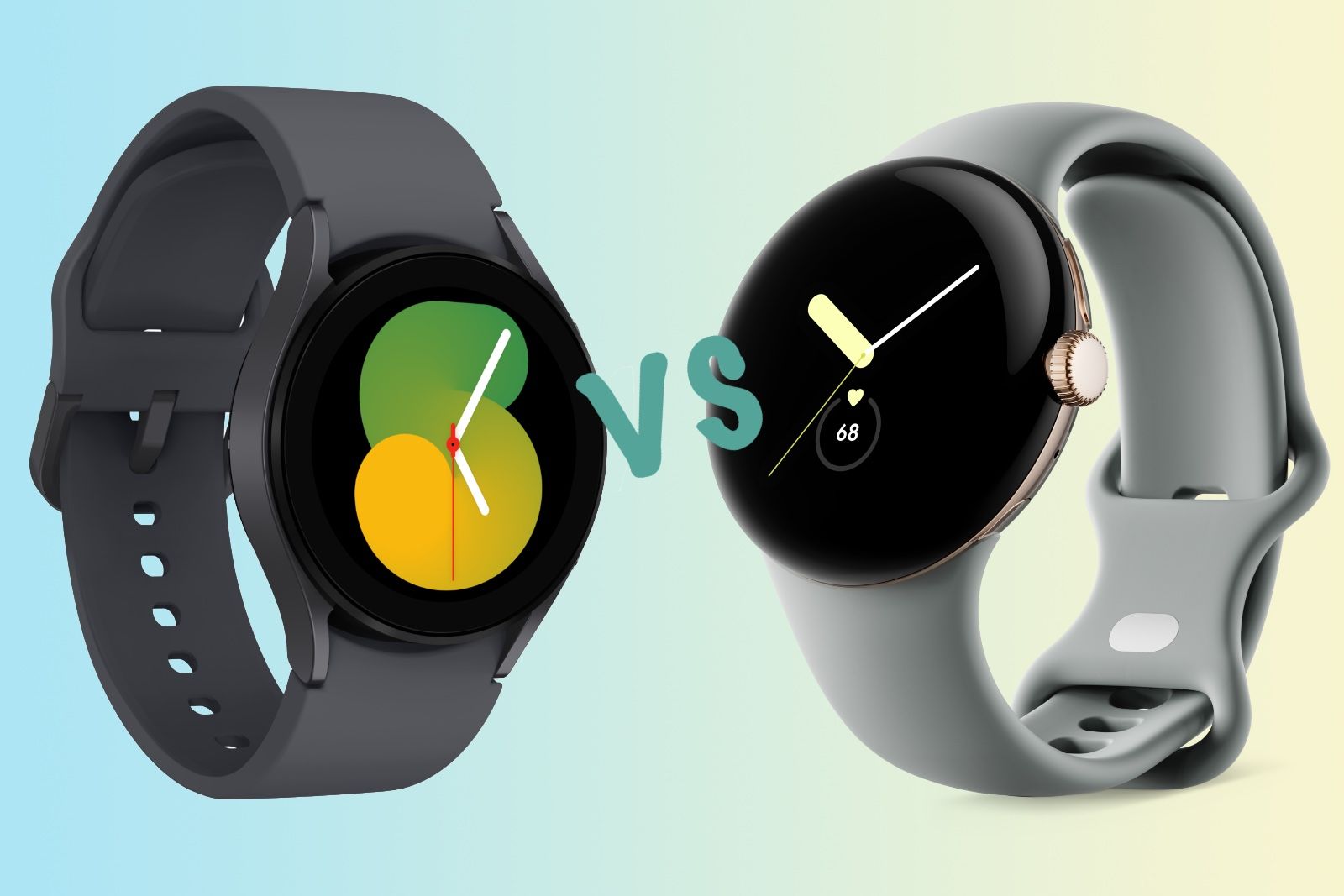With the Pixel Watch, Google has finally built and released its own homemade smartwatch. But with Samsung having been in the market for years, and having already released watches running the latest version of Wear OS, you might be wondering exactly how the two companies' wearables compare.
Unsurprisingly, the two watches do have similarities, but likewise they also have a number of unique aspects that may just sway you to go with one over the other. Whether that's the battery life, design and shape or fitness tracking abilities. Read on to get the lowdown on these two wearables.

Google Pixel Watch
With its combination of great design, fluid software and comprehensive fitness tracking, the Pixel Watch is a great first home-made option from Google.
Design and build
- Pixel Watch: 41 x 41 x 12.3 mm
- Galaxy Watch: 44.4 x 43.3 x 9.8 mm + 39.3 x 40.4 x 9.8 mm
- Pixel Watch: 28 grams - 5ATM waterproof
- Galaxy Watch: 33.5 or 28.7 grams - 5ATM/IP68 waterproof
- Pixel Watch: Matte Black, Polished Silver and Champagne Gold stainless steel cases
- Galaxy Watch: Silver, Graphite (dark grey), Sapphire (blue), Pink Gold aluminium cases
From a purely aesthetic standpoint, it's hard to imagine ever getting confused between the Pixel Watch and the Galaxy Watch 5. Both might be round, but that's about where the similarities end.
Samsung Galaxy Watch 5 - 44mm, Bluetooth (Graphite)
Samsung's Galaxy Watch 5 features a completely flat display on the front, with two buttons placed on the right side of the casing. There's no rotating crown to be seen anywhere. However, that screen is covered in sapphire crystal, making it very scratch resistant and robust.
Pixel Watch on the other hand has a custom Corning-made Gorilla Glass 5 surface which features very extreme curves all the way around to create a seamless rounded edge all the way around the case. It also features just two buttons: one in the middle, which also acts as a rotating crown, and another clickable button just above it.
Where Samsung has something of an advantage is that it offers two different sizes of Galaxy Watch 5. There's a 44mm model and a 40mm version, ensuring Samsung has a watch for those with larger and smaller wrists. Pixel Watch is 41mm only, and for those used to large watches, that may just feel a little too small.
Otherwise, both watches feature similar waterproofing, offering resistance down to 50 metres/5ATM. Samsung's also has an additional IP68 water resistance certification and military standard shock/impact resistance.
Cases are made from different materials and available in different colours too. Google's watch is built from 80 per cent recycled stainless steel and will be available in Matte Black, Polished Silver and Champagne Gold.
The Samsung watch is built from aluminium and comes in Graphite (dark grey) and Silver in both sizes, with the larger model also available in a blue Sapphire finish and the smaller version in a Pink Gold.
With its proprietary camera lens-like mechanism for attaching and removing straps and bands, Pixel Watch means it won't be quite as easy to swap out and get universal bands on Amazon, or other places. Google will offer a number of different colours and materials, however, similar to Apple Watch. Galaxy Watch makes it easier to buy pretty much any quick release watch band, and that generally means it's much cheaper to buy new straps.
Display and software
- Pixel Watch: No size shared - 320 pixels per inch
- Galaxy Watch: 1.4-inch or 1.2-inch - 320 pixels per inch
- Pixel Watch: Wear OS 3.5
- Galaxy Watch: Wear OS 3.5 with One UI Watch 4.5
Google hasn't shared the exact sizing and resolution of the watch's display area. However, with a pixel density of 320 pixels-per-inch, it's pretty much identical to the Galaxy Watch when it comes to sharpness.
Both displays are AMOLED-based too, ensuring that you get excellent contrast and brightness, deep blacks and vibrant colours. It also means you get always-on functionality so that you can see the time all day if you want to.
As for software, both are based on the same version of Wear OS 3.5. Don't let that fool you into thinking they'll look and act the same, however. Like its phones, Samsung has added its own skin called One UI to the Google platform, and that means some elements like watch faces and default functions will be different.
Samsung has its own Samsung Pay service for contactless payments, Samsung Health for health-tracking, and the Bixby assistant for voice commands, among other differences. You can use Google's instead if you want, but Samsung's are the defaults.
Google's Watch will have similar functionality, but with Google's own solutions. That means Google Wallet for payments and Google Assistant for voice commands. On the fitness side, the Pixel Watch will be the first Wear OS watch to come preloaded with the Fitbit health and fitness tracking platform.
Battery, charging, performance and connectivity
- Pixel Watch: 294 mAh battery - up to 24 hours use - wireless charging
- Galaxy Watch: 410mAh/284mAh battery - up to 40 hours use- wireless charging
- Pixel Watch: Exynos 9110 processor - 32GB storage/2GB RAM
- Galaxy Watch: Exynos W920 processor - 16GB storage/1.5GB RAM
- Both: Wi-Fi, Bluetooth 5 and LTE options
One area we may well see a significant difference in performance between the Galaxy Watch 5 and Pixel Watch is in battery. Capacities are similar - the smaller Watch 5 and the Pixel Watch with 284mAh and 294mAh respectively - but Google only rates its own for about 24 hours of use. Samsung claims up to 40 hours is possible on the Galaxy Watch.
In reality, that could mean the difference between needing to charge it every night or just charging it once every couple of days. It also means actually being able to wear it overnight to track sleep, and not feeling the need to charge the watch at night time, every single night.
When empty, or when you're wanting to charge them, they're very similar. The two watches feature wireless charging and make use of a magnetic connection to snap their respective charging pucks on to the underside of the watch.
The two watches both feature Samsung processors, with the Pixel Watch featuring the Exynos 9110 and the Galaxy Watch powered by the Exynos W920. Without using them both, it's hard to determine what that means for speed, fluidity and battery consumption.
Another area you could notice the difference, however, is the storage situation. With 32GB (double the Samsung's 16GB), you'll be able to download more music, watch faces and apps onto the Pixel Watch.
Both watches are equipped with Wi-Fi and Bluetooth 5, giving you the ability to connect to your smartphone and directly to the internet (in order to download apps and sync). You can also get them both as LTE options, letting you stay connected where you have 4G signal, and you don't have your phone. This will depend on which region you're in and whether your carrier supports it though.
Fitness and health tracking
- Both: HR, accelerometer, blood oxygen, GPS tracking, ECG, motion sensors and more.
- Samsung: Body composition measuring
From a fitness perspective, the two watches are very similar. At least, in regards to the hardware that's built in to track various metrics.
The collection of sensors on both watches includes an optical heart rate sensor and the ability to measure your blood oxygen saturation. This, combined with motion sensors means it can not only track how well you're sleeping, but measures how active you are during the day and also how intense your workouts are.
Both watches also feature an electrical signal sensor, and use it for on-wrist ECG, which can be activated to give you more insight into your heart health.
With the Fitbit app onboard, the Pixel Watch can use all this data to give you a daily 'Readiness' score, that can tell you how well recovered you are and if you're in a good place to train/workout.
You can launch into a number of different workout modes on both watches. The Fitbit app has around 40 workout modes to choose from, but if you get a Fitbit Premium subscription you also get access to hundreds of workout sessions to follow along with.
Samsung's watch and accompanying Samsung Health go a little further in some ways. Specifically, measuring things like gait, bounce and ground contact time during runs to inform you how efficient your running style is. You can also perform body composition measurements using the buttons on the watch, to see how much of your body is made up of fat, water and muscle.
Price
- Pixel Watch: from £339
- Galaxy Watch 5: from £269
With prices of the smaller Galaxy Watch 5 starting at just £269 in the UK, it's clear that Samsung's model is more affordable than the Google Pixel Watch. Even the larger 44mm is cheaper than the Google-made watch at £289.
It is - of course - worth remembering that the Pixel Watch is built from stainless steel, which is a more expensive material to build with. As for other functions, however, it might be a hard sell against the Samsung.
Conclusion
With Fitbit onboard, more storage and a really attractive, rounded design built from a premium material, the Pixel Watch is clearly an attractive option for any Android user. Especially since this is Google's very first homemade watch.
From a pure functionality point of view, however, looking at battery life in particular, the Samsung has a lot going for it. Not only is it cheaper, but it's also available in two different sizes and has a more durable glass over the display.
For that reason alone, it's hard not to see it as the best option for most people.

